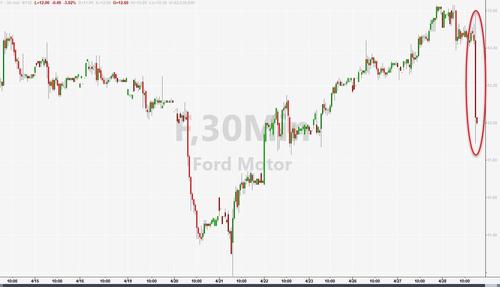Ford Crashes After Slashing Full Year Outlook As Chip Shortage Decimates Production Plan
In case you don't have time to read this, the summary from Ford is as follows: The chip shortage is a shitshow, way worse than anyone expected.
Despite a first-quarter print that was far better than expected...
- *FORD 1Q ADJ EPS 89C, EST. 20C
- *FORD 1Q AUTOMOTIVE REV. $33.6B, EST. $31.3B
But that was not the story, as it seems the impact of the global semi shortage has been dumped into Q2...
- The automaker projected it would generate between $5.5 billion and $6.5 billion in adjusted earnings before interest and taxes, down from a previous forecast for $8 billion to $9 billion.
- Adjusted free cash flow for the full year is projected to be $500 million to $1.5 billion, below the earlier projection for $3.5 billion to $4.5 billion.
and it's far uglier than expected...
Ford said it anticipates a 50% reduction in its planned second-quarter production due to the semiconductor shortage. That’s far worse than the 17% reduction in planned production in the first quarter.
Ford sees a $2.5 billion cost from the semiconductor shortage (at the high end of what CEO Jim Farley had said), but it hopefully expects Q2 “to be the trough of the” impact.
Ford CFO John Lawler on the chip shortage:
“Semiconductor availability, which was exacerbated by a fire at a supplier plant in Japan in March, will get worse before it gets better. Currently, the company believes that the issue will bottom out during the second quarter, with improvement through the remainder of the year.”
There was another ugly data-point to worry about also:
Ford’s market share was down to 5.3% in the first quarter, from 6% at the end of 2020.
Ford lost share in the U.S. and South America, and made very slight gains in Europe and China. Overall, it was down 0.6%.
And that combination has sent the supercharged stock down around 4% after hours...

Bloomberg's Gabrielle Coppola notes that Ford anticipates the flow of semiconductors from the Japan supplier to resume by the end of the second quarter – but, like many others in the industry, that the broader global semiconductor shortage may not be fully resolved until 2022.
Comments
 No Thumbs up yet!
No Thumbs up yet!



